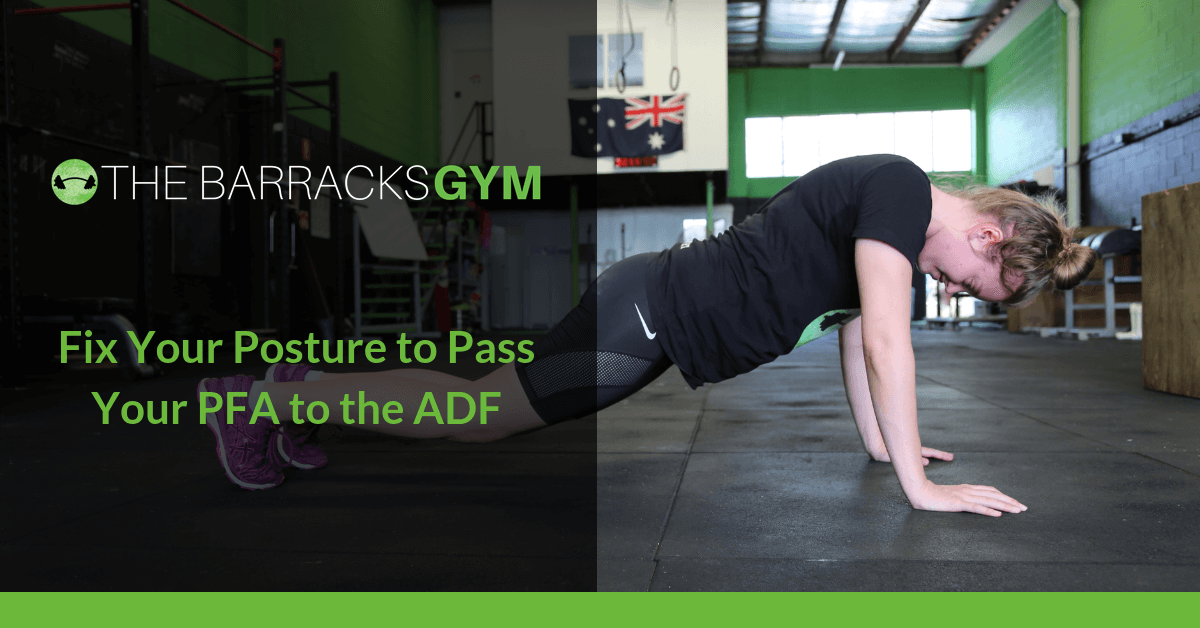|
Many women who are looking to get into the ADF and need to pass the physical fitness assessment come to our gym for advice and help with their workouts. Often we spot common weaknesses at the beginning that could cause serious problems down the line if we just gave them sample workouts to follow focused on the goal only. One of the most critical issues we see is poor posture. It doesn't only increase the chances of injury, but you can't improve beyond a certain level, may that be strength or speed if your posture doesn't support those activities. In this blog, we’ll dig into the topic in more detail, explain how you can identify posture problems, how it could inhibit exercise performance and what you can do to fix your posture and allow your body to get fitter and stronger with injury prevention in mind. What does poor posture look like?No two bodies ar the same and as a result poor posture can mean a variety and a combination of issues. One of the most commons ones is when the upper back between the shoulder blades is rounded more than the natural curvature of the spine and in these cases often the shoulders are hunched or rolled forward too. These are often coupled with forward head posture as well. Most of these issues are attributed to way too many time spent crouching over a desk, looking at computer monitors that are at the wrong angle or smartphone screens in hand seated with a round back. Another common problem that also affects both men and women is the so-called Anterior Pelvic Tilt (APT), which is where your lower back is excessively arched, causing your pelvis to almost dump forwards. Unsurprisingly, APT is also caused by a sedentary lifestyle where your hip flexors are in a shortened position for long periods of time while your glutes are lengthened. This will cause long-term tightness in your hip flexor muscles, that are responsible for moving your knees towards your hips when walking, running, etc. As a result your buttocks will weaken and often the hamstrings will become very tight too. An easy way to find out if you have tight hamstring is to stand in a natural stance, feet hip-width apart, bending over from your hip keeping your legs straight and trying to touch the floor. If you can't do that, next is to check your hip flexors. The twist is that inbalances in your hips caused by APT can affect the rest of your body in ways you wouldn't imagine. From ankle and knee mobility, through lower back pain to shoulder problems, they can all appear as a symptom of APT. These assessments are part of our on-boarding process to ensure we understand our clients' bodies well and that the workout they receive is not only goal-specific, but takes their unique situation into account too. How does posture relate to exercise performance and the PFA?When you undergo your physical fitness assessment for the Australian Defence Force, you’ve got three main exercises to focus on; push-ups, sit-ups, and the beep test (running). Having bad posture will affect your ability to perform all three of these exercises to ADF standards and will pose higher risk of injury on your body when you try. Either way, a poor posture can hold you back from achieving your dream and passing the test that will allow you to join the ADF training. Starting with push-ups, a rounded shoulder could commonly cause impingements in your shoulders and scapula. You may not feel it just yet but as time passes, wear and tear on the joint can cause all kinds of pain and other issues down the line. On the other hand, even though the exercise is predominately chest-based, the shoulders and scapula together with your spine and pelvis are key stabilisers in the movement. If the right muscles can't engage due to poor exercise form caused by your posture, you will less likely to be able to meet the military standard form and hit the required reps. APT will have an impact on your situps performance. Your ability to do ab exercises will be inhibited because of the tight hip flexors and lkely weak core muscles. It’ll be a struggle to get your abs to fire for the required number of reps, and you often find your hip flexors are guilty of activating too much and tiring you out quickly too. Running training for the beep test with bad posture carries the risk of hip flexor strains due to APT and back issues caused by the side-effects of both APT and a rounded upper back. Not many people realise, but your core plays a very important role in running and those muscles can't activate when your shoulders are hunched forward and/or your pelvis is tilted forward too much. How do you fix this?If you want to be in peak physical shape to maximise exercise performance, then you must focus on fixing your posture. Here are a few things you can do:
Complete each superset 3 times, with 10-12 reps on every exercise (apart from the plank where you hold for 30 seconds every set). There’s no need to use heavy weights here, the focus is on exercise technique and ensuring you feel every muscle contracting and working. This is how you turn on the dormant weak muscles and get them firing once more. conclusionSo, you can see how poor posture can affect exercise performance - now make sure it doesn’t harm your chances of passing the PFA. Use the routine above to help you out, and then grab one of our relevant training programs here.
0 Comments
Leave a Reply. |
Most PopularTrusted PartnerWe work with the best service provider for Defence and First Responders.

Get SocialCategoriesArchives
January 2024
|
© COPYRIGHT 2024. ALL RIGHTS RESERVED.


 RSS Feed
RSS Feed